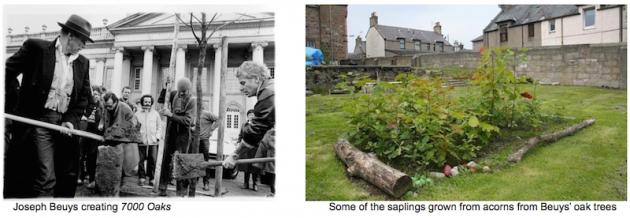My idea would be this time to plant seven thousand oaks in Kassel… And to mark every tree with a little stone, so that everybody after three, two, five or six hundred years can still see that – Joseph Beuys
Inspired by Joseph Beuys seminal 7000 Oaks Deveron Arts has commissioned artist Caroline Wendling to create a new piece of land art to be sited in north east Scotalnd. Through the work Wendling, who comes from Lorraine on the border between France and Germany, will reflect on the possibilities of peace in the context of the WW1 centenary, and explore the legacy of WWI war for contemporary society.
“Joseph Beuys was an artist with an ardent interest in politics, in particular those relating to peace and ecology,” says Claudia Zeiske, Director of Deveron Arts. “He visited Scotland and became entranced by the Celtic tradition, the landscape and the mythological histories of the area. Joseph Beuys’ work has, to a large extent, informed the work of Deveron Arts to date.”
“Beuys came to Scotland, but due to his untimely death never managed to fulfil his ambition to plant an oak wood here. It has been our long-term hope to make Beuys’ dream come true,” she adds.
In 2012 Zeiske collected and seeded acorns from Joseph Beuys’ 7000 oaks project in Kassel some 60 of them have germinated and are now ready to be planted as part of Caroline Wendling’s artwork.
2014 saw the beginning of a programme of commemorations for the First World War. More than 9 million combatants were killed. In Huntly, a rural town of 4,000 people, some 182 soldiers are known to have lost their lives, whilst the number of those that came back wounded and traumatized remains uncounted.
“Beside those who went to war, there were also conscientious objectors who for a variety of reasons refused to fight,” adds Zeiske, “Beuys was particularly interested in the politics of peace so through this new work Caroline is particularly focusing on the WWI conscientious objectors.”
Wendling has started to recruit “an army” of tree planters, and pupils from The Gordon Schools have already collected small stones from the WWI battlefields which will be buried with the saplings at the planting. Meanwhile, Wendling will use limestone from quarries close to the western front in place of the basalt in Beuys’ original work.
She is also be hosting a series of exploratory walks to choose the best site for the oaks in the Huntly area. The tree planting is expected to take place during the weekend of 30 March.
With the help of volunteers, Beuys planted 7,000 oak trees over several years in Kassel, each with an accompanying basalt stone. It was an extensive artistic and ecological intervention into the extensive urbanization of the setting with the goal of enduringly altering the living space of the city. The project, though at first controversial, has become an important part of Kassel’s cityscape.
The project was of enormous scope, and met with some controversy. While the biggest difficulty of the project was raising the money, the project had its share of opponents. Much of it was political, from the conservative state government dominated by the Christian Democrats. (The mayor of Kassel was a social democrat who stood by Beuys). Some people thought the black stone markers were ugly, even piling pink stones on the sites in 1982 as a prank. However, as more trees were planted people’s perception of the project met with increasing tolerance.
The display of a tree with a solid stone, at first glance, may be an enigma by itself. It generates questions and full of wonders that consecutively lead to additional questions. What is this eccentric juxtaposition of the gray solid stone with the green-leaf tree trying to represent? As with most of Beuys’ art works, the underlying philosophy embedded in the 7000 Oaks project is to encourage the challenge towards the established assumptions. However, it is not merely a denial against the conventional perceptions, but rather a desire for a new attitude. The solid stone that stands beside the ever-changing tree is a symbolic representation that brings out this message. These two natural and yet oppositional qualities are complementary and coexisting harmoniously. As a symbol of regeneration, a slow progressive growing oak tree represents a continuous transformation of life, society and the entire ecological system.

